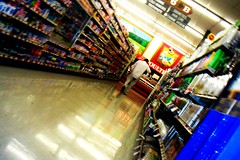The 3 Secrets of Screen Placement: Location, Location, Location
While researching screen placement, I came across a presentation by TNS Sorensen (PDF format) that explains some of the peculiar things that go on inside the typical retail environment. (The presentation is a few years old but still quite relevant.) For instance, did you know that in a typical supermarket, the right side slightly outsells the left side simply because people tend to come in, turn to the right, and then make a counter-clockwise circle (hence the right side always get shopped, while the left side might get short-circuited)? For that matter, did you know that counter-clockwise shoppers on average spend about $2 more than clockwise shoppers? While such minutiae might seem irrelevant to your digital signage plans, they're actually quite important. For example, while we've all seen instances of screens evenly distributed around the racetrack, this is arguably not the best approach. Perhaps putting more screens on the right side -- where we know the audience will be larger and fresher -- will be favorable. Or maybe better utilization on the left side, where the average shopper will be approaching the end of her trip, might help encourage a few last-minute purchases. While I can't predict which approach would perform better in any given retail situation, I do know that evenly distributing the screens in the name of aesthetics or feng shui or whatever is probably not optimal.
Tips for Staying Relevant to Your Retail Audience
The whole key to digital signage is relevance. Our job is to put the right information in front of the right person (or people) at the right place and time. It's no small feat, to be sure, but when done properly digital signage offers a messaging platform that few other media can match. However, even if you've developed content that gets you 90% of the way to connecting with your core audience, here are a few tips that can help to put you over the top:
- We like to look down on our purchases: We pick things up, hold them in our hands, and generally look down at them while doing so (obviously things like sunglasses are an exception). During that time, we're engaged with the object, not any external media. Consequently, screens placed in areas with handle-able items might work for drawing traffic to an area, but may fall short of connecting with those in the area who are inspecting an item.
- We buy on our left when pushing a cart down a "walled" aisle, but otherwise we buy on our right: While both sides of a reasonably large aisle will remain in our field of view, our field of attention might actually be to the left on walled aisles, and trend to the right otherwise. That has some pretty interesting implications for screen positioning and angling.
- Our dominant flow is from the back of the store to the front: In a store with a "racetrack" configuration (a big aisle ring around a bunch of smaller aisles in the middle), most people tend to enter those smaller middle aisles from the back, rather than the front. Consequently, if you're on a budget and can't afford to deploy screens that face both directions, you might get more bang for your buck by positioning the screens to face the back of the store.
Even your content will come across differently depending on where it's played back in the store. And while that goes for obvious things like showing contextually relevant content (think cold medicine spots and health bulletins in the pharmacy section), it's also true for more subtle variations based on shopper habits. For example, Sorensen found that the beginning of a shopping trip tends to favor newer and less familiar items. While I haven't tested it out myself, that might also mean that advertisements for newer products might perform better closer to the entrance, rather than near the checkout aisle, for example. Likewise, front-facing end caps will favor recognized brands (where shoppers can make a quick selection, and don't need to spend much time thinking about it). Thus, the content on those endcap screens should focus on quick blasts of features and benefits, instead of comparisons with other brands or products. The reverse is true for rear-facing endcaps: these, Sorensen found, are more suitable for less familiar brands, probably because shoppers tend to move a bit slower in the back of the store, and can thus take some extra time to consider these new products.
It's unfortunate that even great research by the likes of TNS Sorensen and others needs to carry a caveat that your mileage may vary. No two stores are alike, and no two shoppers are alike. That makes coming up with any kind of generalizations like the ones above very, very hard. Moreover, once researchers do come up with some broad and useful guidelines, the practicality of acting on them has to be weighed against how "typical" your venue and your shoppers are. Get too far away from the average, and suddenly the guidelines might not work out for you. They could even make things worse. But if the tips above teach us one thing, it's that people do think and act differently in different parts of a store, and during different phases of their shopping trips. While the one-size-fits-all content approach employed by many retail TV networks is certainly economical, research like this increasingly suggests that it's far from the best thing to do with your screens.
Have you used shopper behavior data to decide where to place your screens, e.g. putting more screens on the right side of the store instead of the left? Did you get any pushback from venue owners or advertisers who wanted everything to be equally spaced?


 Subscribe to the Digital Signage Insider RSS feed
Subscribe to the Digital Signage Insider RSS feed
Comments
RSS feed for comments to this post